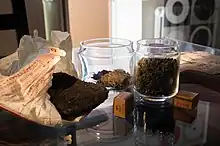Chinese tea
Chinese tea generally refers to a variety of teas which are grown or consumed in China.
 | |
| Country of origin | China |
|---|---|
| Ingredients | Tea leaves |
| Chinese tea | |||||||||||||||||||||
|---|---|---|---|---|---|---|---|---|---|---|---|---|---|---|---|---|---|---|---|---|---|
| Traditional Chinese | 茶 | ||||||||||||||||||||
| Simplified Chinese | 茶 | ||||||||||||||||||||
| Literal meaning | Tea | ||||||||||||||||||||
| |||||||||||||||||||||

Chinese tea can be classified into six distinctive categories: white, green, yellow, oolong, black and post-fermented. Others add categories for scented and compressed teas. All of these come from varieties of the Camellia sinensis plant. Most Chinese teas are cultivated and consumed in China. It is commonly available in Chinese restaurants and grocery shops worldwide. Green tea is the most common type of tea consumed in China.
Within these main categories of tea are vast varieties of individual beverages. Some of the variations are due to different strains of the Camillia plant. However, the largest factor in the wide variations comes from differences in tea processing after the tea leaves are harvested. White and green teas are heat-treated (simplified Chinese: 杀青; traditional Chinese: 殺青; pinyin: shā qīng) soon after picking to prevent oxidization, often called fermentation, caused by natural enzymes in the leaves. Oolong teas are partially oxidized. Black teas are fully oxidized. Other differences come from variations in the processing steps.
History
The practice of drinking tea has a long history in China, having originated there. Although tea originated in China, during the Tang dynasty, Chinese tea generally represents tea leaves which have been processed using methods inherited from ancient China. According to legend, tea was discovered by Chinese Emperor Shen Nong in 2737 BC when a leaf from a nearby shrub fell into water the emperor was boiling.[1][2] Tea is deeply woven into the history and culture of China. The beverage is considered one of the seven necessities of Chinese life, along with firewood, rice, oil, salt, soy sauce and vinegar.[3]
Song dynasty
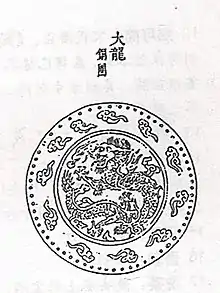
Tea was an important crop during the Song dynasty. Tea farms covered 242 counties during this time. This included expensive tribute tea, which was tea from Zhejiang and Fujian provinces that was exported to Southeast Asian and Arab countries.
In the Song dynasty, tea started to be pressed into tea cakes (usually black tea). Some were embossed with patterns of the Chinese dragon and the Phoenix, and were called exotic names including:
Large Dragon tea cake, Small Dragon tea cake, Surpassing Snow Dragon ball cake, Fine Silver Sprout, Cloud Leaf, Gold Money, Jade Flower, Inch of Gold, Longevity Sprout, Eternal Spring Jade Leaf, Dragon in the Clouds, Longevity Dragon Sprout, Dragon Phoenix and Flower, and Eternal Spring Silver Sprout.
Ming dynasty
The Ming dynasty scholar Wen Zhenheng's encyclopedic book Zhǎng Wù Zhì (simplified Chinese: 长物志; traditional Chinese: 長物志; Treatise on Superfluous Things), volume 12, contains the descriptions of several famous Ming dynasty teas.
During Ming, tea was a form of currency also used to pay imperials tribute. Ming dynasty founder Zhu Yuanzhang (also known as the Hongwu emperor) was born to a poor family and understood the difficulties of the lives of farmers. He abolished the compressed tea brick style and replaced it with the whole, loose-leaf tea style, and also declared people instead pay tribute with tea buds.[4] This amendment especially helped relieve tea farmers of some of the pressures of the laborious and complicated tea production processes.[5] These complex processes for farmers included: steaming tea leaves, breaking them down into fine remnants, mixing the powder with plum juice, then baking them with molds to shape into tea bricks.[6]
Culture
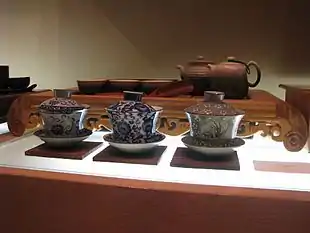
Customs and etiquette
In some places of China, in restaurants, it is common for customers to clean their bowls and utensils at the table by rinsing them with tea from the pot. Tea may be poured over utensils into one of their bowls, or a larger bowl is may be provided as a waste receptacle for tea used to rinse bowls. In restaurants in China, tea is usually served in lieu of water, and hence tends to be a light drink flavoured.[7]
However, when sipped as a daily beverage, Chinese people tend to use a special personal tea bottle, in which water is allowed to infuse with tea leaves for hours, and sipped continuously. This method, which is more prevalent in day-to-day Chinese life, involves the repeated use of the same tea leaves throughout the day.[7]
Utensils
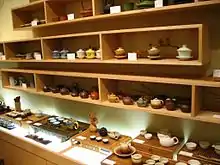
A traditional Chinese tea set consists of special clay or porcelain teapots, teacups, tea spoons, tea strainers, draining trays, tea forceps (for the leaves), a large forceps (for the tea cups) and occasionally, tea caddies. All of these are kept on a special wooden tea tray with an inbuilt draining arrangement and a holder for the drained water. however, in more modern times, specially built electric hotplates for tea sets are used by some Chinese people.[7]
Tea houses
Chinese tea houses refer to the public place where people gathered to drink tea and spend their spare time. Chinese tea houses have a long history. It first took shape during the Tang dynasty Kaiyuan era (713–714)[8] and became common during the Song dynasty. From the Ming and Qing dynasties, tea house culture became integral to regional culture.[9]
Drinking morning tea is a custom within various provinces regardless of what status or identity people are. People often go to tea house in twos to threes to relax, be entertained, and gather information all while sipping tea. One could find old folks reminiscing over their joys and sorrows, or youth discussing their ambitions.[10]
In 1970s, Chinese tea houses spread to Hong Kong. Some notable ones include “Yen Yen”, “Tsui Heung Yuen”, “Pak Cheuk”, “Yin Bun Lau”, and “Wun Tin”, among others. Merchants would use tea houses as a place for exchanging information and business. For example, a jade merchant might complete a transaction in a tea house.[11]
A tea garden is a tea house which features a Chinese garden or a domestic Chinese garden in which people enjoy their tea.
Ba-Shu culture and Sichuan teahouses
Sichuan teahouses have various sizes. The large ones have hundreds of seats, while the small ones, only a few. They also have excellent services. Traditional Sichuan teahouses use red copper teapots, tin saucers, teacups with covers made of Jingdezhen porcelain, tuocha- a bowl-shaped compressed tea leaves- and tearoom keepers expert at all manner of work. What's more, Sichuan teahouses have social functions. They play an important role in spreading the state affairs information. People can chat with each other there. They also serve as unofficial courts.[12]
Wu-Yue culture and Hangzhou teahouses
Wu-Yue area is famous for tea producing and green tea produced in Zhejiang province play a decisive role. In Hangzhou, most tearooms are elegant, simple and unsophisticated. They emphasize making tea with good-quality water and tasting tea in an excellent environment in order to achieve the true meaning of tea art.[13]
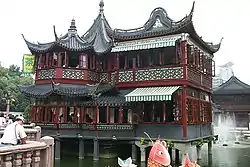
Tianjin teahouses, Shanghai Fuchaguan teahouses and Guangdong tearooms
Most of the Tianjin teahouses meet the needs of business people from different parts of China. People of various trades drink tea while eating refreshments and appreciating performances which include singing of opera arias, storytelling and dagu (a versified story sung to the accompaniment of a small drum and other instruments).
In the past, Shanghai teahouses are regarded as learned and refined places in Shanghai. Shanghai people called teahouses fuchaguan to express their longing for leisure. The most typical teahouse with local features was situated in the old Chenghuangmiao area.
The old Guangdong tearooms were inexpensive. Regular customers would be served with a cup of tea, and two steamed buns stuffed with diced grilled pork, steamed dumplings with the dough gathered at the top, or dumplings with shrimp stuffing. However, teahouses become different now. Nowadays, customers are provided with a pot of strong tea as soon as they arrive, and have many choices from a great variety of refreshments on the food cart.[14]

Beijing teahouse culture
Beijing teahouses show most of the advantages of other local teahouses. They are known for their various functions, and rich and profound cultural aims.
There are many kinds of Beijing teahouses, which include Shuchaguan, Qingchaguan, Qichaguan, Yechaguan, Dachaguan, and Erhunpu.[15]
Specific tea house types
Teahouse culture made a special contribution to the development of the novel, and shuchaguan was the best evidence to explain. At shuchaguan, tea is only acted as a medium and supplement because people came mainly to listen to storytelling. Storytelling was performed two times a day and a long story would last two or three months. Famous shuchaguan were exquisitely furnished with cane or wooden tables and chairs, and decorated with works of calligraphy and painting in order to build an atmosphere for storytelling. The purpose of drinking tea in shuchaguan is increasing their historical knowledge, killing time and amusing themselves. So shuchaguan were best suited to old people.[16]
Qingchaguan provides places for people from all walks of life to entertain themselves elegantly. In the past, most of the Qingchaguan were simply furnished with square tables and wooden chairs. Teacups with covers were used to serve tea. However, tea was served without refreshment in Qingchaguan.[17]
Qichaguan provides places for customers to play chess. Qichaguan were simply furnished with timber or lumps of wood painted with chess boards, which were partly buried in the ground, or chessboards with benches on both sides. When people played chess while drinking tea, they will feel that the chessboards was like a battlefield of life. Usually they would temporarily forget about their sufferings, and that's why tea was also called wangyoujun (Mr. Worry-free).[18]
People went to Yechaguan to appreciate beautiful gardens. People of Beijing in old times were keen on enjoying beautiful scenes in different seasons. So yechaguan were mostly built in those places with beautiful gardens and nice views.[19]
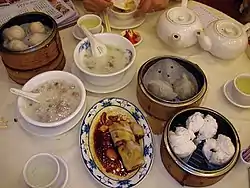
Dachaguan provided tea, food and services to people in various trades such as business men and scholars. In terms of service, it includes Hongluguan, Wowoguan and Banhuguan.[20]
Hongluguan were installed with red stoves which baked Manchurian and Chinese pastries. They served all kinds of pastries, which were smaller and more exquisite than those made by pastry shops. Customers could drink tea while sampling these pastries.[20]
Wowoguan served various refreshment, including aiwowo, steamed sponge cakes, paicha, pengao and sesame seed cakes.[21]
Characterized by a large copper pot, banhuguan suited varied tastes.[21]
Erhunpu served tea without refreshments but provided dining and wining facilities. It supplied customers with food cooked from in-house ingredients or ingredients brought by customers.[21]
Literature
Literature about tea during the Ming dynasty largely focused on tea pickers, with writings and artwork regarding aspects such as tea picking and processing.
Tea-picking Poem - Gao Qi[22]
It is getting warm after the spring rain and thunder,
New tea leaves start sprouting among branches.
Girls with silver hairpins sing folk songs to each other,
Competing to pick the most tea leaves in the shortest time.
They get home with the fresh scent of tea leaves on their hands,
The highest qualities will be sent to the Prefecture first.
The newly baked tea leaves are not tasted yet,
They are packed into baskets and will be sold to Hunan merchants.
Satirical poems and songs were also created and reflected struggles of tea farmers and ridiculed greedy officials.[23] After Mid Ming, the amount of tribute tea soared due to an increased pressure upon citizens by higher bureaucrats. Officials demanded higher taxation and escalation of the requirement of tribute tea.[23] Some citizens began to grow angry with these demands, including poets Gao Qi and Han Bangqi.[23] Although their main occupations were government officials, they were also generally acknowledged writers who voiced their complaints through poems that became widespread folk ballads. Through their writings they requested the reduction of taxation and tributes. However, Gao was accused by the government of "involvement in a rebellion conspiracy”[24] and was executed, while Han was imprisoned by officials wanting to hide their written works.[23]
Fuyang Ballad - Han Bangqi[25]
Tea-picking women and fish-catching men
Feudal officials torture them so they don't even have unscathed skin
How come the Heaven is not humane?
Have people here done anything wrong?
Symbolism and significance
The China famous tea (Chinese: 中国名茶; pinyin: zhōng guó míng chá) or The Ten Great Chinese Teas (Chinese: 中国十大名茶; pinyin: zhōng guó shí dà míng chá) are the ten most notable Chinese teas. Below is a list of ten common teas in China.[26]
| Chinese | English | Region | Type |
|---|---|---|---|
| 西湖龙井 | Longjing tea (also spelled Lungching; 'Dragonwell') | Hangzhou, Zhejiang | Green tea |
| 洞庭碧螺春 | Biluochun tea (also spelled Pi lou chun, 'Green snail spring') | Suzhou, Jiangsu | Green tea |
| 安溪铁观音 | Anxi Tieguanyin tea | Anxi, Quanzhou, Fujian | Oolong tea |
| 黄山毛峰 | Huangshan Maofeng tea | Huangshan, Anhui | Green tea |
| 武夷岩茶-大红袍 | Wuyi tea, e.g., Da hong pao ('Big red robe') | Wuyi Mountains, Fujian | Oolong tea |
| 君山银针 | Junshan Yinzhen ('Jun Mountain silver needle') | Yueyang, Hunan | Yellow tea |
| 祁门红茶 | Keemun Black tea | Qimen, Huangshan, Anhui | Black tea |
| 六安瓜片 | Lu'an Melon Seed tea | Jinzhai, Lu'an, Anhui | Green tea |
| 云南普洱 | Yunnan Pu'er | Pu'er City, Yunnan | Post-fermented tea or "dark" tea |
| 白毫银针 | Baihao Yinzhen ('White tip silver needle') | Fuding, Ningde, Fujian | White tea |
Production
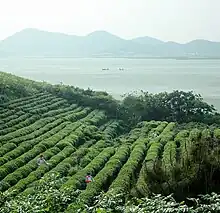

The highest grades of white tea, yellow tea, and green tea are made from tender tea shoots picked early spring. These young tea shoots may consist of a single terminal bud, a bud with an adjacent leaf or a bud with two adjacent slightly unfurled leaves. It is generally required that the leaves are equal in length or shorter than the buds.
The more-oxidized tea—such as red or oolong tea—are made from more mature leaves. For example, the Anxi Tieguanyin (grown in the tea region of Anxi in Fujian), is made from one bud with two to four leaves.
Not all high grade green tea is made from tender tea shoots. The highly regarded green tea Lu An Gua Pian is made from more matured leaves.
Traditionally these tender tea shoots are picked before 5 April, or Qingming Festival. The standard practice is to start picking when 5% of the garden is ready, or when the tea buds reach certain size. In some tea gardens, tea shoots are picked daily, or every 2 days.[27]
Tea farmers
Tea households were normally small, family-based operations for tea cultivation.[28] There were also tea merchants who set up tea firms to create their own tea plantations and/or to process tea leaves after buying from local tea farming families.[28] Different from tea households, seasonal workers were often employed by tea firms. Seeking work during the harvesting seasons, they often took boats to Tunxi, Anhui and other places where tea leaves were abundant.[28]
Tea production process
Harvesting tea was heavily dependent on weather conditions, so tea could not usually be produced throughout the entire year. Various weather conditions throughout different areas limited tea to be grown in a few specific regions: Jiangnan, Jiangbei, Hunan and Xinan.[29] These areas provided stable warm weather and rainfall- two essential components of growing tea plants. The general production of loose, whole-leaf teas mainly included: tea seedling plantation, fertilization/weeding/spraying, tea picking, sunning/firing/rolling, and sorting and packaging.
Tea picking
Tea picking was a central component of the entire tea production process. Time spent working and the intensity of labor fluctuated due to the inability to accurately predict weather conditions. This created uncertainties regarding ideal tea picking times. However, generally “the ideal time for picking tea leaves was early morning before sunrise.”[30] Tea pickers would usually leave their homes early and do work using careful techniques efficiently to ensure the leaves were gently picked in whole.[31] To do so, pickers used one or both hands to nip the green stems with their index fingers and thumbs, then held the leaves until they had palms-full before tossing the leaves into their baskets.[31] Women were preferred for this occupation because of their ability to more gently and carefully pick off the whole tea leaves.[32] No matter the age or marital status, women were expected to be capable of performing this duty.[28] However, there were also limitations on women during this time. According to Luo Lin's Explanation of Tea, women were not allowed to participate in any aspect of tea making during their menstrual periods.[33] They were to avoid “female pollution” from their “unclean” bodies.[28]
Sunning, firing and rolling
After picking tea leaves, families first sorted out the damaged or rotten leaves then began the sunning process.[28][34] This process inhibited water evaporation within tea leaves to promote oxidation.[35] Over-oxidation can alter the taste of the tea to become "grass-like" or thick and bitter,[36] so farmers heated the leaves to stop the oxidation once the desired level was reached- a process known as 'firing'. Then, leaf cells were broken down by gently rubbing the tea leaves- this process helped volatilize the scents and tastes when brewing. Tea leaves were damped then rolled into shapes, making its storage convenient[37] while also allowing sap to squeeze out and provide additional flavoring.[38]
Sorting and packaging
Once the leaves were dried again, they were sorted and packaged and sold. Tea was usually "transported by a train of porters who used carrying poles to transport multiple chests of tea to the shippers",[39] as the tea was largely sold to merchants and also largely produced to be exported.
Trade
China has experienced declining trends in tea export growth rate since the mid-1990s. Compare to 1980s that the export volume is decreased 232 tons to 170 tons, is around 26.7%, because the coverage of tea safety standards and Maximum Residual Limit of pesticides negatively affected China's exports.[40]
The increase in export of green tea from China has not been commensurate with production. During 2010, China exported 234 M kg of green tea as against 163 metric kg in 2001. Its share of export in the global market has been found to fall from 87% to 78% between 2003 and 2007. However, in 2010, China contributed 79% of the total green tea exported worldwide.
Varieties
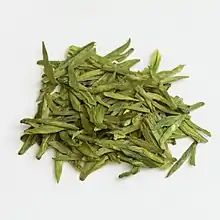
Spelling of varieties often reflects English usage, and historical or southern-Chinese pronunciation rather than official modern pinyin, for example; Bohea (武夷茶 wǔyí chá), Congou (工夫 gōngfu), Hyson (熙春茶 xīchūn chá), Souchong (拉普山小種 lāpǔshān xiǎozhǒng), Chunmee (珍眉 zhēnméi), Sowmee (秀眉 xiùméi), Pekoe (白毫 báiháo), Keemun (祁門紅茶 qímén hóngchá).[41]
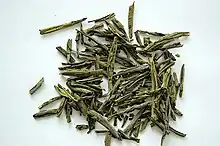
See also
- All In This Tea, a 2007 documentary
- List of Chinese teas
- Taiwanese tea
References
- "Tea and the Chinese way of life". radio86.com. Archived from the original on August 16, 2011. Retrieved January 9, 2012.
- "Chinese Culture Tea". Archived from the original on 2020-08-07.
- "Notes on Chinese Culture - Food and Drinks (08) – Chinese Tea". dict.cn. Archived from the original on August 4, 2012. Retrieved January 9, 2012.
- Congshu Bianweihui 叢書編委會, ”明初飲茶方式的變革” (The Revolution of Tea Drinking Styles in Early Ming), 大中國上下五千年:中國茶文化(Five Thousand Years of Greater China: Chinese Tea Culture), (August 2010): 20 – 21, p 20.
- Benn, James A. (2015-02-28), "Religion and Culture in the Tea Economy of Late Imperial China", Tea in China, University of Hawai'i Press, pp. 172–197, doi:10.21313/hawaii/9780824839635.003.0008, ISBN 9780824839635
- Gleason, Carrie. “All the Tea in China,” The Biography of Tea, p. 10 (Crabtree Publishing Company, 2007), p. 10.
- Tong, Liu (1 June 2010). Chinese tea - the definitive guide (2nd ed.). Beijing: China Intercontinental Press. ISBN 978-7508516677.
- 茶馆
- Wang, Ling (2001). Chinese Tea Culture : The Origin of Tea Drinking. Selangor Darul Ehsan, Malaysia: www.pelanduk.com. p. 69. ISBN 978-9679787788.
- Li, XiuSong (Fall 1993). "Chinese tea culture". Journal of Popular Culture. 27 (2): 75–90. doi:10.1111/j.0022-3840.1993.00075.x – via Social Science Database.
- Cheung, Chi Kong (19 April 2011). "Yen Yen Chinese Restaurant is the jade merchants' place of gathering". Hong Kong Memory. Retrieved 25 February 2019.
- Wang, Ling (2001). Chinese Tea Culture. Malaysia: Pelanduk Publications. p. 70. ISBN 978-967-978-778-8.
- Wang, Ling (2001). Chinese tea culture. Malaysia: Palenduk. pp. 72–76. ISBN 978-967-978-778-8.
- Wang, Ling (2001). Chinese tea culture. Malaysia: Palenduk. pp. 76–79. ISBN 978-967-978-778-8.
- Wang, Ling (2001). Chinese tea culture. Malaysia: Palenduk. p. 79. ISBN 978-967-978-778-8.
- Wang, Ling (2001). Chinese Tea Culture. Malaysia: Palenduk. pp. 80–82. ISBN 978-967-978-778-8.
- Wang, Ling (2001). Chinese Tea Culture. Malaysia: Palenduk. pp. 82–83. ISBN 978-967-978-778-8.
- Wang, Ling (2001). Chinese Tea Culture. Malaysia: Palenduk. pp. 83–84. ISBN 978-967-978-778-8.
- Wang, Ling (2001). Chinese Tea Culture. Malaysia: Palenduk. pp. 84–85. ISBN 978-967-978-778-8.
- Wang, Ling (2001). Chinese Tea Culture. Malaysia: Palenduk. p. 86. ISBN 978-967-978-778-8.
- Wang, Ling (2001). Chinese Tea Culture. Malaysia: Palenduk. p. 87. ISBN 978-967-978-778-8.
- Gao Qi 高啟, “採茶詞” (Tea-picking Poem), 高啟大全集(Collections of Gao Qi), Shijie shuju(1964).
- Liao, Jianzhi (2007). Ming dai cha wen hua yi shu. Shi di zhuan ji lei (1 ban ed.). Taibei Shi: Xiu wei zi xun ke ji gu fen you xian gong si. ISBN 9789866909399. OCLC 180690119.
- E., Strassberg, Richard (1994). Inscribed landscapes : travel writing from imperial China. Berkeley: University of California Press. ISBN 9780520914865. OCLC 44957693.
{{cite book}}: CS1 maint: multiple names: authors list (link) - Han Bangqi 韓邦奇, “富陽民謠” (Fuyang Ballad), 苑洛集 (Anthology of Yuanluo) 22.
- "list". Retrieved March 18, 2011.
- Amazing-Green-Tea.com, "The Chinese Green Tea Crown Jewel"., www.amazing-green-tea.com
- Lu, Weijing (2004). "Beyond the Paradigm: Tea-Picking Women in Imperial China". Journal of Women's History. 15 (4): 19–46. doi:10.1353/jowh.2004.0015. ISSN 1527-2036. S2CID 145448480.
- Chew, Derek (2012-11-01). "Understanding China's Tea Harvest". American Specialty Tea Alliance. Retrieved 2019-03-11.
- Lu, Weijing. “Beyond the Paradigm: Tea-picking Women in Imperial China,” Journal of Women’s History 15, 4 (2004): 19 - 46, p. 25.
- Mo, Liyun 莫麗蕓. “南方有嘉木——我本草木”(Jiamu Tea in the South – I Was to Be Vegetation), 美人美茶(The Beauty of People and Tea) (2017): pp. 2 – 27, p. 4.
- Qian, Nancy (August 2008). "Missing Women and the Price of Tea in China: The Effect of Sex-Specific Earnings on Sex Imbalance*". Quarterly Journal of Economics. 123 (3): 1251–1285. doi:10.1162/qjec.2008.123.3.1251. ISSN 0033-5533.
- Luo Ling 羅廩. “茶解” (Explanation of Tea). Beijing Shi: Quan guo tu shu guan wen xian suo wei fu zhi zhong xin, 2003.
- Gardella, Robert (2001). "Tea Processing in China, circa 1885: A Photographic Essay". The Business History Review. 75 (4): 807–812. doi:10.2307/3116512. ISSN 0007-6805. JSTOR 3116512. PMID 18572486. S2CID 38903664.
- Mo, Liyun 莫麗蕓. “南方有嘉木——我本草木”(Jiamu Tea in the South – I Was to Be Vegetation), 美人美茶(The Beauty of People and Tea) (2017): pp. 2 – 27, p. 12
- Bhattacharyya, Nabarun; Seth, Sohan; Tudu, Bipan; Tamuly, Pradip; Jana, Arun; Ghosh, Devdulal; Bandyopadhyay, Rajib; Bhuyan, Manabendra; Sabhapandit, Santanu (2007-03-26). "Detection of optimum fermentation time for black tea manufacturing using electronic nose". Sensors and Actuators B: Chemical. 122 (2): 627–634. doi:10.1016/j.snb.2006.07.013.
- Mo, Liyun 莫麗蕓. “南方有嘉木——我本草木”(Jiamu Tea in the South – I Was to Be Vegetation), 美人美茶(The Beauty of People and Tea) (2017): pp. 2 – 27, p. 15.
- Li, Guang (2007), Ling Chun Chin, ed., "The Traditional Processing of Wuyi Rock Teas: An Interview with Master Ling Ping Xang", The Art of Tea, Wushing Book Publisher (2): 76–83
- Gardella, Robert (2001). "Tea Processing in China, circa 1885: A Photographic Essay". The Business History Review. 75 (4): 807–812. doi:10.2307/3116512. ISSN 0007-6805. JSTOR 3116512. PMID 18572486. S2CID 38903664.
- Wei, Guoxue; Huang, Jikun; Yang, Jun (2012). "The impacts of food safety standards on China's tea exports". China Economic Review. 23 (2): 253–264. doi:10.1016/j.chieco.2011.11.002. ISSN 1043-951X.
- Kit Boey Chow, Ione Kramer All Teas in China Page 179 1990 "for promotion purposes, many non-Chinese companies borrow names from Chinese teas, such as Bohea, Congou, Hyson, Souchong, Chunmee, Sowmee, Pekoe, Keemun, etc. Such labels may contain little or no tea of ..."
Further reading
- Evans, John C., Tea in China: The History of China's National Drink. Contributions to the Study of World History, Number 33. Greenwood Press: New York; Westport, Connecticut; London, 1992. ISSN 0885-9159, ISBN 0-313-28049-5
- Forbes, Andrew ; Bently, David (2011). China's Ancient Tea Horse Road. Chiang Mai: Cognoscenti Books. ASIN: B005DQV7Q2
External links
 Media related to Tea of China at Wikimedia Commons
Media related to Tea of China at Wikimedia Commons
